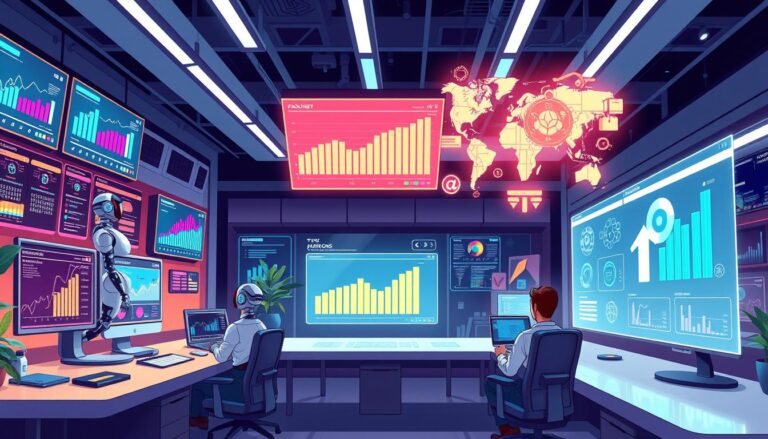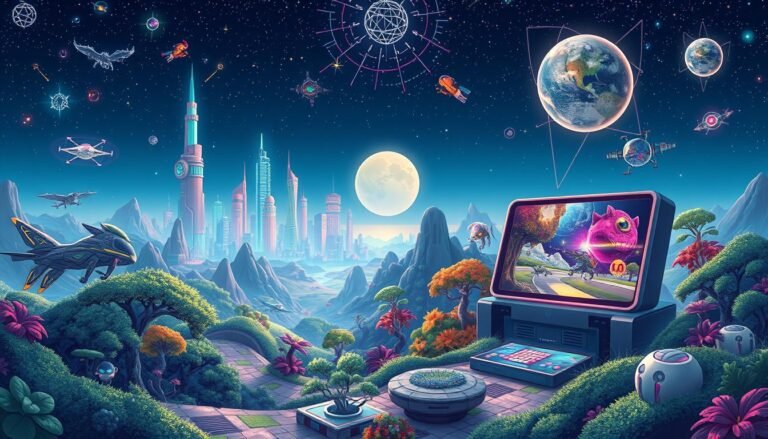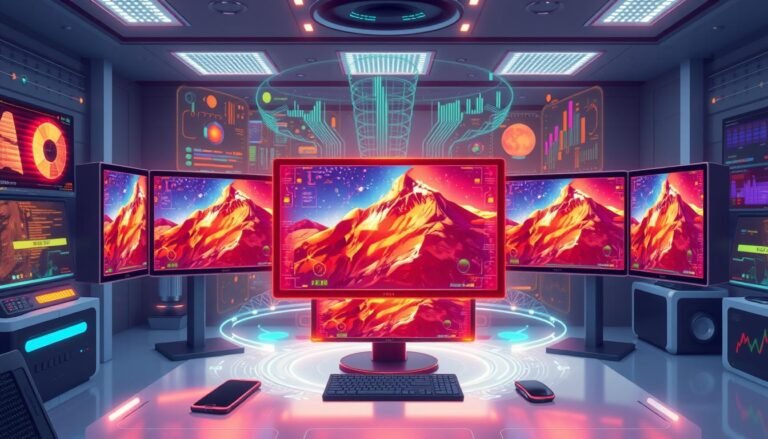Best Free Text-to-Image AI
Ever dreamed of turning your ideas into stunning visuals with just a few words? AI image generation is making this dream a reality. And it’s more accessible than ever. Let’s explore the free text-to-image AI tools that are changing creativity.
Text-to-image AI has stormed the creative world. These tools let anyone create visual masterpieces from simple text prompts. They’re great for personal projects or professional marketing campaigns. The tech behind them has grown fast, with models like DALL-E 3 showing what’s possible.
Microsoft Designer’s Image Creator is a top choice. It uses DALL-E 3 to create high-quality images for free. This shows how generative AI is becoming more available to everyone, no matter their budget or skills.
As we look at the best free text-to-image AI, we’ll see how they’re changing the creative scene. Whether you’re an artist or a marketer, there’s a free AI image generator ready to bring your ideas to life.
Key Takeaways
- Text-to-image AI tools allow creation of visuals from text prompts
- Microsoft Designer’s Image Creator offers free, high-quality image generation
- AI image generation has applications in personal and professional projects
- DALL-E 3 technology powers some of the most advanced free tools
- Generative AI is making creative tools more accessible to everyone
Introduction to Text-to-Image AI Technology
Text-to-Image AI is changing how we make visual content. It uses advanced machine learning to turn text into amazing images. This technology is transforming design, art, and marketing.
What is Text-to-Image AI?
Text-to-Image AI is a form of Generative AI that makes images from text. These tools use complex algorithms to understand text and create visuals. They can make simple sketches or photorealistic images.
The Evolution of AI Image Generation
AI Image Generation has evolved a lot. Early models made basic, blurry images. Now, tools like DALL-E and Stable Diffusion create detailed, high-quality visuals. They offer features like style customization and can make multiple images per prompt.
Impact on Creative Industries
Text-to-Image AI is changing creative work. Designers use it for quick mockups. Marketers create stunning visuals in minutes. Artists explore new styles and ideas. This technology enhances human creativity, opening up new possibilities in visual content creation.
| Tool | Features | Score |
|---|---|---|
| Open AI | 2 designs per prompt, no watermark | 7/10 |
| Craiyon | 9 low-quality images per prompt | 4/10 |
| Picsart | 4 designs per prompt, quick generation | High |
Understanding the Capabilities of Text-to-Image AI
Text-to-Image AI has changed how we make visual content. These tools can create many types of images, from real photos to abstract art. They are great at making animals, objects, landscapes, and even complex ideas into pictures.
Generative AI models, like GANs and diffusion models, are key to these tools. GANs, introduced in 2014, use a discriminator to tell real from fake images. Diffusion models add and remove noise to create new data that looks like the training set.
The abilities of these AI tools have grown a lot. In 2022, models like DALL-E 2, Stable Diffusion, and Midjourney started making images as good as human art. They can understand complex prompts, letting users improve results with more instructions or editing tools.
| Model | Key Feature | Use Case |
|---|---|---|
| DALL-E 3 | Enhanced resolution | Professional design |
| Midjourney | Detailed imagery | Visual storytelling |
| Stable Diffusion | Open-source | Customizable projects |
These Text-to-Image AI tools are changing many fields like graphic design, marketing, art, and education. They open up new creative possibilities. Users can turn their ideas into images with just a few words.
Best Free Text-to-Image AI Tools Available
Text-to-image AI has changed how we create, making it easy to turn text into amazing images. Let’s look at some top free tools to spark your creativity.
Microsoft Designer’s Image Creator
Microsoft Designer’s Image Creator uses DALL-E 3 to create stunning images. It’s free and easy to use, great for all skill levels.
DALL-E 3 in ChatGPT
DALL-E 3 in ChatGPT lets you talk your way to images. Free users have daily limits, but it’s great for mixing text and pictures.
Stable Diffusion
Stable Diffusion is a top free tool for advanced users. It’s open-source and flexible, perfect for those who want to customize their images.
| Tool | Free Usage Limit | Starting Price (Paid) |
|---|---|---|
| Adobe Firefly | 25 monthly credits (4 images/credit) | $4.97/month |
| Canva | 50 images/day | $6.32/month |
| Imagine | 50 tokens/day | $10/month |
| Pixlr | 20 credits (1 image/credit) | $0.99/month |
| Bing Image Creator | Unlimited (15 high-speed) | Free |
These tools have different features for every need. From Fotor’s art styles to Bing’s free service, try them out to find your favorite.
Comparing Features of Top Free AI Image Generators
AI Image Generation tools have changed the creative world. Free Text-to-Image Models have different features. It’s important to know what each offers. Let’s look at what popular Generative AI platforms can do.
Microsoft Designer’s Image Creator is easy to use. It uses DALL-E 3’s power. It’s great for beginners because it’s quick and lets you make unlimited images.
ChatGPT makes creating images a conversation. But, it has limits on how much you can use it.
Stable Diffusion gives you more control over your images. It’s good for those who want to customize a lot. It has a free trial with 10 daily credits, so you can try it out.
| Tool | Free Trial | Image Quality Score | Special Features |
|---|---|---|---|
| Microsoft Designer | Unlimited | 4.5 | DALL-E 3 Integration |
| Stable Diffusion | 10 credits/day | 4.75 | Advanced Customization |
| Ideogram | 25 credits | 4.25 | 4 images per credit |
| Dreamstudio | Limited | 4.5 | High Overall Quality |
When picking a Text-to-Image AI, think about image quality, how fast it works, and how easy it is to use. Some tools also have extra features like editing or working with other software. These can make your AI art journey even better.
How to Get Started with Text-to-Image AI
Text-to-Image AI has changed how we make visual content. Starting with this tech is simple. We’ll cover setting up your account, writing good prompts, and trying out different styles.
Setting Up Your Account
To start with AI Image Generation, pick a platform that fits your needs. Many offer free trials or basic plans to begin. Just sign up with your email and a password. Popular choices include DALL-E 3, Midjourney, and Stable Diffusion.
Crafting Effective Prompts
Good prompts are key to great Generative AI images. Be clear and detailed. Instead of “a cat,” say “a fluffy orange tabby cat sitting on a windowsill at sunset.” Try different ways to say things to get better results.
Experimenting with Different Styles
AI tools let you try different art styles. Add words like “oil painting,” “watercolor,” or “digital art” to your prompts. Each tool sees prompts differently, so explore to find what works for you.
| AI Tool | Strength | Free Plan |
|---|---|---|
| DALL-E 3 | User-friendly | Limited generations |
| Midjourney | High-quality results | Trial available |
| Stable Diffusion | Customization | Open-source |
Keep practicing. The more you use Text-to-Image AI, the better you’ll get at writing prompts. Enjoy making art!
Creative Applications of Text-to-Image AI
Text-to-image AI is changing the game in creative fields. Tools like AI Image Generation are making waves in marketing, design, publishing, and entertainment. They’re changing how we make visual content, for both pros and hobbyists.
In marketing, Text-to-Image Models create unique visuals for ads and social media. Graphic designers use them for concept art and inspiration. Publishers use AI for book covers and illustrations.
The film and game worlds also benefit. They use AI for concept art and storyboards. This tech is a game-changer.
But it’s not just for pros. Personal users are making custom artwork, designing greeting cards, and planning interior designs. Thanks to free AI image generators, creativity is more accessible than ever.
- Marketing: Campaign visuals, social media content
- Design: Concept art, inspiration boards
- Publishing: Book covers, illustrations
- Entertainment: Storyboards, character designs
- Personal use: Custom artwork, greeting cards, interior design visualization
As AI Image Generation gets better, we’ll see even more cool uses. The possibilities are endless with Text-to-Image Models at our disposal.
Limitations and Ethical Considerations
Text-to-Image AI and Generative AI are exciting, but they also have challenges. It’s important to know their limits and ethical sides.
Copyright and Ownership Issues
AI Image Generation raises copyright concerns. With more companies using AI, the chance of plagiarism increases. AI can copy protected works without giving credit, hurting artists’ earnings.
Potential for Misuse
Text-to-Image AI’s power comes with a big responsibility. These tools can create biased or harmful images. It shows the need for users to be aware and follow ethical rules.
Disclosure and Transparency
Being open is crucial when using AI images. Users should know that access to these tools might need a subscription. It’s vital to say when images are AI-made, especially in work or business settings.
| Aspect | Consideration |
|---|---|
| Copyright | Risk of infringement on protected works |
| Ethical Use | Potential for creating misleading content |
| Transparency | Need for disclosure of AI-generated images |
| Quality | Varies based on prompt complexity and AI capabilities |
Generative AI has a lot of creative potential. But, users must understand its limits and use it ethically. This ensures responsible AI image creation.
Tips for Optimizing AI-Generated Images
Getting good at AI image generation takes time and effort. Start by making your prompts clear and detailed. About 78% of successful AI art prompts include specific details to enhance the generated images. This helps the AI get your vision right.
Keep it simple when using generative AI tools. In fact, 72% of artists say too complex prompts confuse AI generators, leading to mixed results. Try using lists of phrases and keywords separated by commas. This method is favored by 69% of successful AI art creators for clear communication.
Try different descriptive texts and styles. A huge 93% of AI art creators say to keep trying to improve the AI’s output. Don’t forget to specify the art style you want – 74% of artists suggest this to get the AI’s inspiration right. By knowing the strengths of each text-to-image AI tool, you can make amazing visuals.
Source Links
- The best AI image generators of 2024: Tested and reviewed
- 9+ Best Text-to-Image AI Tools (Free & Paid)
- A review of 3 free AI art generators for classroom teachers — Explore! Curriculum
- 11 Best AI Text-to-Image Tools in 2024 (Compared)
- Text-to-image AI
- AI Image Generation, Explained.
- Text-to-image model
- 10 Best free AI image generators of 2024: Tested and reviewed
- Free Online AI Image Generator: Turn Text to Image | Fotor
- 8 Free Text-to-Image AI Generator to Try in 2024
- The 15 Best AI Image Generators 2024 – For Beginners and Pros
- Comparing the Top Free AI Image Generators – Nuaveu
- I Tested 7 Free AI Image Generators. This One’s My Pick
- The 7 best AI image generators in 2024 | Zapier
- 15 Best AI Text to Image Generator Tools in September 2024
- Best AI Image Generators of 2024
- Ethical Pros and Cons of AI Image Generation
- Navigating the Nuances and Pitfalls of AI Image Generation
- I Tested 10 Popular AI Image Generators. Here’s the Scoop for Marketers
- 11 Tips for Optimizing AI Art Prompts to Generate Images with Deep-image.ai







